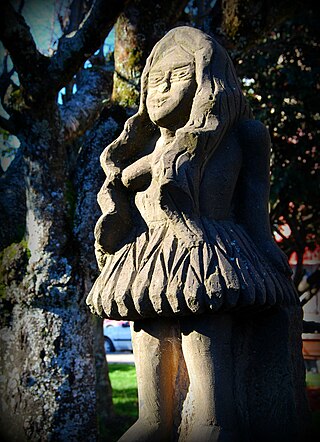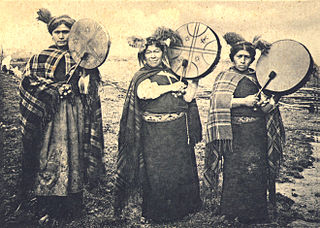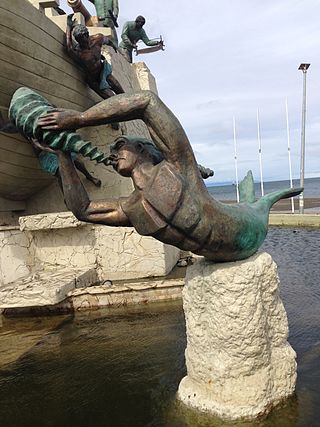
Chiloé Island also known as Greater Island of Chiloé, is the largest island of the Chiloé Archipelago off the west coast of Chile, in the Pacific Ocean. The island is located in southern Chile, in the Los Lagos Region.
The Caleuche, also called The Enchanted Ship, Barcoiche, The Ghost Ship, or The Warlocks' Ship, is a legendary ghost ship from Chilote mythology in southern Chile.

In the traditional Chilote mythology of Chiloé, Chile, the Trauco is a humanoid creature of small stature—similar to a dwarf or goblin—who lives deep in the forest. It has an ugly face and legs without feet.

The Sigbin or Sigben is a creature in Philippine mythology said to come out at night to suck the blood of victims from their shadows. It is said to walk backwards with its head lowered between its hind legs, and to have the ability to become invisible to other creatures, especially humans. It resembles a hornless goat, but has very large ears which it can clap like a pair of hands and a long, flexible tail that can be used as a whip. The Sigbin is said to emit a nauseating odor.

The common vampire bat is a small, leaf-nosed bat native to the Neotropics. It is one of three extant species of vampire bat, the other two being the hairy-legged and the white-winged vampire bats. The common vampire bat practices hematophagy, mainly feeding on the blood of livestock. The bat usually approaches its prey at night while they are sleeping. It then uses its razor-sharp teeth to cut open the skin of its hosts and lap up their blood with its long tongue.

Curanto is a traditional Chilote method of cooking food using heated rocks buried in an earth oven that is covered with pangue leaves and turf. The fundamental components are seafood, potatoes, along with other traditional preparations from Chiloé Archipelago such as milcao and chapalele, to which are added meats, sausages and sometimes crustaceans.

The Pincoya is, according to local mythology, a female "water spirit" of the Chilotan Seas. The Pincoya is said to have long blond hair, be of incomparable beauty, be cheerful and sensual, and rise from the depths of the sea.

Chilote is a dialect of Spanish language spoken on the southern Chilean islands of Chiloé Archipelago. It has distinct differences from standard Chilean Spanish in accent, pronunciation, grammar and vocabulary, especially by influences from local dialect of Mapuche language and some conservative traits.

The religion of the indigenous Mapuche people of south-central Chile and southwestern Argentina is an extensive and ancient belief system. Legends and myths are common to the various groups that make up the Mapuche people. These myths tell of the creation of the world and the various deities and spirits that reside in it.

In the Chilote folklore and Chilote mythology of Chiloé Island in southern Chile, the imbunche is a legendary monster that protects the entrance to a warlock's cave.
The Chilote mythology or Chilota mythology is formed by the myths, legends and beliefs of the people who live in the Chiloé Archipelago, in the south of Chile. This mythology reflects the importance of the sea in the life of Chilotes.
The Warlocks of Chiloé are people of Chiloé Archipelago said to practise witchcraft linked to Chilote mythology. The warlocks may be real, purported or legendary persons. The source of the witchcraft is often attributed to a legendary encounter between Basque navigator José de Moraleda y Montero and Huilliche machi Chillpila who defeated Moraleda in a duel of witchcraft obtaining a book of European magic as reward. Belief in witchcraft has been common in the archipelago reaching such influence, that in 1880 Chilean authorities put on trial warlocks said to rule the archipelago through a secret society.
The Basilisco chilote is a creature from Chilota mythology originating from the Chiloé Archipelago, in southern Chile.
The Colo Colo or Colocolo is an evil rat-like creature from Mapuche mythology. The marsupial monito del monte is sometimes called "colocolo" due to its similarity with the mythical beast.
Chilean mythology includes the mythology, beliefs and folklore of the Chilean people.

The Chiloé Archipelago is a group of islands lying off the coast of Chile, in the Los Lagos Region. It is separated from mainland Chile by the Chacao Channel in the north, the Sea of Chiloé in the east and the Gulf of Corcovado in the southeast. All islands except the Desertores Islands form Chiloé Province. The main island is Chiloé Island. Of roughly rectangular shape, the southwestern half of this island is a wilderness of contiguous forests, wetlands and, in some places, mountains. The landscape of the northeastern sectors of Chiloé Island and the islands to the east is dominated by rolling hills, with a mosaic of pastures, forests and cultivated fields.
Desmodus draculae is an extinct species of vampire bat that inhabited Central and South America during the Pleistocene, and possibly the early Holocene. It was 30% larger than its living relative the common vampire bat. Fossils and unmineralized subfossils have been found in Argentina, Mexico, Ecuador, Brazil, Venezuela, Belize, and Bolivia.
La Sirena chilota is an aquatic creature belonging to the Chilote mythology. Perhaps its origin is due to binding of the myths of the Sumpall of the Mapuche mythology and the Mermaid of European mythology. Like to the mermaids, the siren chilota is characterized by a body half fish and half woman, with blond hair and golden scales; and her human side would look like a very beautiful teen. She would be the youngest daughter of Millalobo and the human Huenchula. Commissioned by her father, she has the task of caring for all fish. Also helps her siblings to carry the bodies of drowned sailors, toward the Caleuche, for the purpose of reviving the sailors and to be happy. Sirena Chilota have very large flukes and strong tails so they can swim long distances while carrying victims of tragedies. It is also said that a Sirena chilota's tears are very delicate and, if used in a spell, is very powerful.
The Caballo Marino Chilote is an aquatic creature of the Chilote mythology of Chile, that bears some resemblance to the hippocampus.

Millalobo is an important being in Chilote mythology. He is the most powerful being of the sea after Caicai and was chosen by Caicai to be his representative and govern all that resided in the sea.










